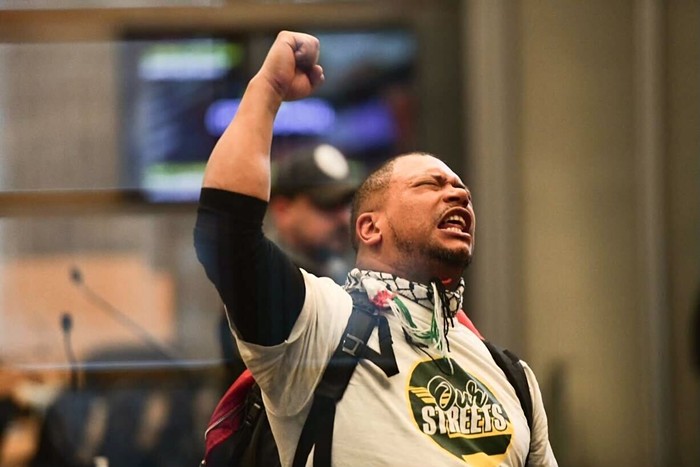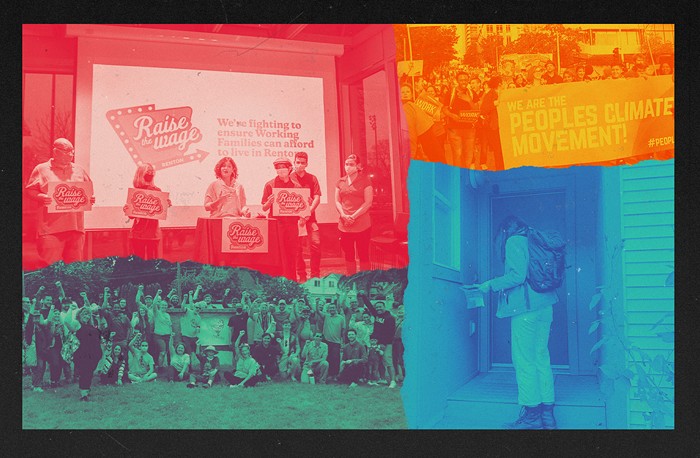Burkheimer wants to see that change, say neighborhood folks who've heard his ideas. Instead of a single-story building with a grocery store, he'd rather have a tall building anchored by a main-floor grocery. Several big glass doors would open right onto Broadway from deli and produce departments, alongside windows running the length of the building so people could look inside the store and see what's in stock. There would be underground parking for customers and the public. And most importantly, a few floors of housing would cap off the project--possibly bringing it to 65 feet in height--so people could live above Broadway.
Burkheimer, a longtime Broadway property owner who also holds the QFC property near Seattle Center, declined to elaborate on his plans. "The [city] says it is interested in assisting," he says. "As usual we are getting bogged down in the 'Seattle process.' Call me in about a year or two, after Broadway hits bottom."
Just three blocks south of QFC, at Thomas Street--in an office above Metro Clothing Company's window full of brightly clad mannequins--Monica Moe, as executive director of Businesses of Broadway (BOB), was working on a plan that could help Burkheimer and other Capitol Hill developers get six-story development dreams off the ground. Unfortunately, before the plan was finished, the city pulled the plug on BOB and Moe. Now, the door of BOB's tiny second-floor Broadway office is locked, and the plans are stalled.
What began in 1999 as a progressive idea to fix troubled Broadway--an idea to let developers like Burkheimer build tall mixed-use structures to beef up the commercial core, increase density, and add more housing--can be compared to the original Dick Falkenbury monorail vision: It took a long time for other folks to catch on, and when they did, the city got irritated and squashed it. It's the same story on Capitol Hill--the city seems to have just squashed the neighborhood's lofty plans, after practically ignoring them for four years. But, like the monorail believers, Broadway advocates aren't giving up. There's too much at stake.
Currently, Broadway is a mess. On a recent Saturday morning, a few men roamed Capitol Hill--on Pine Street, and on Denny Way over Interstate 5--with signs advertising the closing sale at Broadway's Wherehouse Music at John Street. "40-60% Off!" the red, yellow, and white signs screamed. It seems a metaphor for the once booming commercial strip.
This week there are a dozen empty storefronts on Broadway. The number fluctuates slightly month to month, but it's been about the same in the six blocks surrounding Burkheimer's property, from Denny Way to Roy Street, for at least the past two years. Some spaces have been empty that whole time--like the Godfather's Pizza location at Denny Way--while others eventually get leased out after a few months of sitting empty. But there's always another empty storefront looming in the wings. The Gap, arguably Broadway Market's most prominent tenant, recently left Broadway. Uzuri, an African trinket store in the Broadway Market, is having a moving sale. Wherehouse Music will be empty soon. And record store Cellophane Square just moved a few spaces south, leaving an empty storefront at the corner of John Street in the prominent building that might be razed sooner or later for a Sound Transit station.
There are other things adding to Broadway's woes. Business owners--and many of their customers--complain about aggressive panhandling, graffiti, overflowing dumpsters, even simple things like light poles in need of a fresh coat of paint. Some merchants want more cops on the street, while others just want better basic upkeep. Sales have dropped for most merchants over the past few years, according to one longtime business owner--a result of the sluggish economy, merchants say, and customers who choose University Village and downtown (which got a $73 million garage plus other pricey facelifts in the mid-'90s, courtesy of the city) over the dingy Broadway retail strip. And when the city's University District "Ave Project" is finished this summer, some merchants fear they'll face even stiffer competition for customers, as people who want a Mexican dinner, some used jeans, or a new record will choose the spiffed-up Ave over Broadway.
Broadway is "arguably Seattle's most vibrant and interesting commercial street. Active day and night, [Broadway] is the heart of Capitol Hill's social scene. At 1.6 miles long, Broadway is the longest continuous pedestrian commercial street in Seattle." Those inspiring words weren't from a fluffy tourist brochure--they are lifted right from the 1999 Capitol Hill Neighborhood Plan. It's right on target: Broadway is the coolest strip in Seattle. It's in the city's densest neighborhood, Capitol Hill, with 25,000 residents and 6,000 businesses. "We've got more residents and more employment up here than anywhere else," touts Capitol Hill Chamber of Commerce president Charlie Hamilton. (For comparison, Wallingford has 20,000 residents, while Ballard and the Central District each have about 18,000. Those neighborhoods each boast about 2,000 businesses--in other words, it takes all three to match Capitol Hill's business strength.) Capitol Hill is also the site of Seattle's International Film Festival, Gay Pride events, the annual Capitol Hill Block Party, and Seattle's Fringe Festival, to name a few. This is one hopping neighborhood.
But it could be better--the people who worked on the neighborhood plan knew that Capitol Hill was the closest thing Seattle had to a real urban center, but it had lots of room for improvement. They laid the groundwork for a long-term revitalization that could make the area around Broadway the best neighborhood on the West Coast.
The grand plan? A wide-scale Broadway transformation that changes the structure and architecture of the street. Or, as the neighborhood plan says, "small-scale, pedestrian-oriented streets predominated by storefront buildings that provide an eclectic mix of shops, restaurants and services for residents and visitors. The community would like... commercial districts to provide more housing in upper stories."
There's a perfect example already, at John Street--the busiest and liveliest corner of Broadway. One of the reasons it's so busy? At the northeast corner of the intersection, the five-story Capitol Building Apartments--Broadway's tallest building--puts residents from 52 apartments right on Broadway. Those residents patronize the shops below--a newsstand, a restaurant, and a clothing store, plus the nearby drugstore and bookstore. There are always people on that corner, catching a bus, or reading magazines at the newsstand. It's a real city scene.
And it's a scene that can be replicated all up and down Broadway. The key is encouraging taller buildings like the one Burkheimer has in mind, which would allow for housing above street level (more people could actually live on Broadway). That would mean more eyes on the street to watch out for crime, and more customers to patronize the businesses. The denser residential area would make Broadway a bustling hub, which would in turn attract new businesses that want to be a part of Broadway, the gem of Capitol Hill. Approving taller buildings on Broadway--65 feet, or up to six stories, instead of the current 40 feet--would also spur property owners to redevelop, since they'd be able to recoup their investments in new structures.
That kind of visionary development is already happening in one spot on Broadway, at a Roy Street corner lot that was empty for years, and it's evidence of what these taller projects can bring to Broadway. Though only four stories tall, it almost got city approval to build to 65 feet, in exchange for public amenities like hosting the Seattle Public Library's Capitol Hill branch. The library eventually opted to stay put a few blocks away, effectively killing the height waiver proposal, but the mixed-use project will still be the anchor of the north end of Broadway. When it's finished later this year, the project will have several shops on the ground level as well as underground parking and 57 units of housing upstairs. Merchants at the north end of Broadway are looking forward to its completion, which will bring a new population to their part of the neighborhood.
Unfortunately, the Roy Street project and the five-story Capitol Building Apartments at John Street are reminders of what the rest of Broadway could be. Unfortunately, the other buildings along Broadway are drab, low, and dated.
Seattle's leaders have expressed support for neighborhood density in the past, especially in areas like Broadway that may support future transit lines--like the monorail or light rail. Council member Judy Nicastro has publicly said the city will look at land code changes to "add a lot of height to neighborhoods," which will increase density around transit. "There are ways to do it where you still have open space and you don't feel like you're in a tunnel," she's said.
Meanwhile, Mayor Nickels, and even King County Executive Ron Sims, has gotten on the density bandwagon--about Northgate. When Nickels announced a plan to free up Northgate developers, Sims praised it, saying the plan "will create the kind of environment that allows people to live and work in one place."
And business leaders have praised the recent influx of residents to the downtown core--residency increased 75 percent in the last 10 years, to 20,000 people.
What's the holdup on Capitol Hill? Well, in order for developers to build taller buildings on Broadway, they need zoning changes from the city. But in order for the city to approve raising the roofs on Broadway, it needs to see numbers proving that it's a good idea. The city council and the Department of Design, Construction and Land Use won't change height regulations on a whim. So in 1999's neighborhood plan, Capitol Hill folks pegged a study of Broadway--looking at the heights, zoning, and economics of the street--as one of their neighborhood's highest priorities.
Luckily, the plan caught the attention of a few visionary property owners who, with the support of Broadway businesses, got the study going. They found some cash, and hired a consultant to do the analysis.
But four years after the neighborhood deemed it a priority, the study was only a third of the way finished, languishing in a downtown real estate office. It seemed the taller, grander Broadway idea was dead.
Monica Moe was the driving force behind the study. Moe, a thirtysomething woman with long brown hair and rectangular glasses, was the former executive director of Businesses of Broadway (BOB), which helped get the study rolling. BOB was the workhorse that handled money for Broadway's Business Improvement Association (BIA). The city would collect extra taxes from Broadway business owners, and that money would return to the BIA. Then Moe, at BOB, administered the BIA's money, writing checks to pay for services like street cleaning. But Moe went beyond check writing, getting the neighborhood together on long-term ideas like building taller projects on Broadway, and bolstering the neighborhood's BIA by adding property owners. As a paid employee, Moe had the luxury of devoting herself completely to Broadway, lobbying the city aggressively for help with the ailing area. In her spare time, she drove the study forward.
When she first joined BOB, soon after the neighborhood plan was approved--following a stint as PR director for Cornish College of the Arts--Moe started working with property owners, business owners, and the city to get the crucial study jump-started. There was quite a bit of progress: Several property owners chipped in money (which they hoped the city would match, as was suggested in the neighborhood plan) and hired Allen Safer at Integra Realty Resources-Seattle to begin the study.
But Broadway needed more cash for the study to be completed. The city approved a $10,000 Neighborhood Matching Fund grant for the study in August 2001, but the money was never paid out. "The grant is still there," says Department of Neighborhoods sector manager Darlene Flynn. It's possible the part of the study covered by the grant wasn't reached.
While trying to sort out the study's money, BOB had its own financial problems. The annual Cirque de Broadway festival, a weekend-long street fair meant to draw folks to Broadway, left BOB with a hefty debt--$90,000, according to the city.
BOB reps went to the city last fall, hoping to work out a strategy to operate a stripped-down BOB (no more Cirque de Broadway, for starters) and pay off the debt over a few years with BIA funds. The city seemed into the idea, Broadway sources say, and was willing to help out with a loan to keep BOB afloat.
That changed in November. BOB needed emergency cash to pay the bills, and the city wasn't coming through like it had apparently said it would. Around Thanksgiving, a harsh letter from BOB reportedly landed in the Office of Economic Development (the department that was supposed to help BOB out), the mayor's office, and city council offices.
Apparently, the letter ticked off city administrators (The Stranger has filed a public record request for the letter). The loan deal was nixed, and BOB was officially closed on December 31, 2002. According to the city, BOB "no longer exists."
"We came to a conclusion that we couldn't, in good faith, work with BOB," says Jennifer Davis Hayes, in the city's Office of Economic Development. She declined to elaborate. One has to wonder why an administration would kill a neighborhood organization that was getting a lot accomplished and had a plan to get out of the red. Hopefully it wasn't another tantrum from Greg "My Way or the Highway" Nickels.
Meanwhile, the study, without Moe's solid Broadway advocacy shepherding it along, fell apart. "We shut the job down, awaiting further direction. We're just on hold," Safer says.
"We had a driving force when we had Monica working with us," says Allan Jones, a Broadway property owner. "She put a tremendous amount of energy into it. Now we're trying to push it along ourselves."
Mayor Nickels unwittingly took the city's behind-the-scenes Capitol Hill snafu public when he gave his State of the City speech on February 3. When Nickels listed half a dozen neighborhoods that the city planned to help out this year, Capitol Hill--and troubled Broadway in particular--was conspicuously absent. Neighbors and business owners were irate at Nickels when The Stranger busted the mayor for his gaffe ["Mayor to Cap Hill: Drop Dead," Amy Jenniges, Feb 6].
After getting called out for ignoring Capitol Hill, Nickels' staff seems to be working overtime to catch up with what the neighborhood's been doing since 1999. The Office of Economic Development (OED) has plans for the neighborhood, and the heights study is now on the city's agenda. "We're currently working with business and property owners to revive the old highest and best use study," says Nancy Yamamoto, OED real estate projects manager. (Property owner Allan Jones is part of that effort--"It isn't dead," he confirms.) The city will undertake an open hiring process for an analyst (possibly bringing back Safer), and Yamamoto hopes the study will be under way again later this spring.
And the study will be part of the city's overall revitalization strategy for Broadway--which includes "expanding the long-term residential base, attracting and retaining additional retail businesses, increasing public safety, and implementing the neighborhood planning objectives," Yamamoto says.
The Office of Economic Development has already begun work on Broadway, signing an April 1 contract with Shirley Bishop, Inc. to provide management services for the BIA "on a much more direct level," OED's Hayes explains. In other words, the merchants will get the basic services they pay for through the BIA taxes, like street cleaning and flower baskets or holiday lights.
It's great that the city is finally on the Broadway beat, but the neighborhood is still getting shortchanged, and the neighbors feel slighted by the city's lack of attention. "We're all eagerly waiting to hear what the mayor's office and OED have in terms of suggestions for helping Broadway," says Randy Wiger, chair of the Capitol Hill Neighborhood Plan Stewardship Council. Even if the city's on board now, it's not a replacement for a community organization like BOB or a staunch neighborhood advocate like Moe.
At the city council, neighborhood plan guy Richard Conlin says it will be tough to get the heights study completed without community pressure. Since the neighborhood planning process was completed, he points out, there's only been one neighborhood zoning study done in the city. That one was in the Madison-Miller area between Capitol Hill and the Central District, "and I had to shepherd that through," Conlin explains. "It really needs to have a champion, either on the council or internally [in the city]. Someone needs to establish it as a priority. I don't know that the mayor's office has established it as a priority."
The neighborhood doesn't think so either, despite the recent OED efforts. First of all, neighbors simply aren't happy with Nickels--who campaigned regularly on Broadway and Capitol Hill, where he won 64 percent of the vote (compared to 50.9 percent citywide), but snubbed the neighborhood once he took office. His adminstration also seems to have put the kibosh on Moe and BOB. And secondly, Capitol Hill is skeptical: It seems disingenuous that the city and the mayor's office are getting involved with Broadway now. This late in the game, the city has its work cut out for itself.
"When we talk about the city process, we talk about geologic time," says Deluxe Bar and Grill owner Barry Rogel, one of the many fixtures of Broadway who'd like to see more from the city. "Broadway deserves to be extremely high on any list because of what it represents. It doesn't get its fair share of services, it doesn't get represented [by the city council]. So it is up to the mayor to listen to the concerns up here and act on them. It's more than fair for this neighborhood to demand that."
He's absolutely right. Years after the neighborhood made its priorities known, Capitol Hill is still demanding city attention. It's the densest neighborhood in town, and it has incredible potential to get even denser. The city needs to step in to match the neighborhood's effort--by getting the heights study finished, for starters. Then tweak the zoning, and let the developers who want to improve the area have at it, with plenty of neighborhood input on design, as per the neighborhood plan. Hopefully the mayor's office and OED can recapture the spirit of Monica Moe and finish up what she and the neighborhood started. Burkheimer, and the rest of Broadway, is waiting.


















